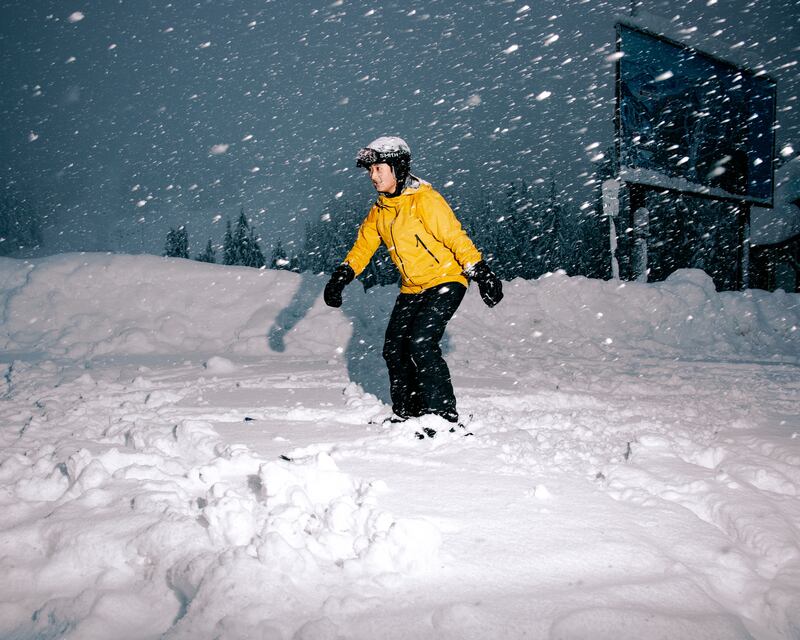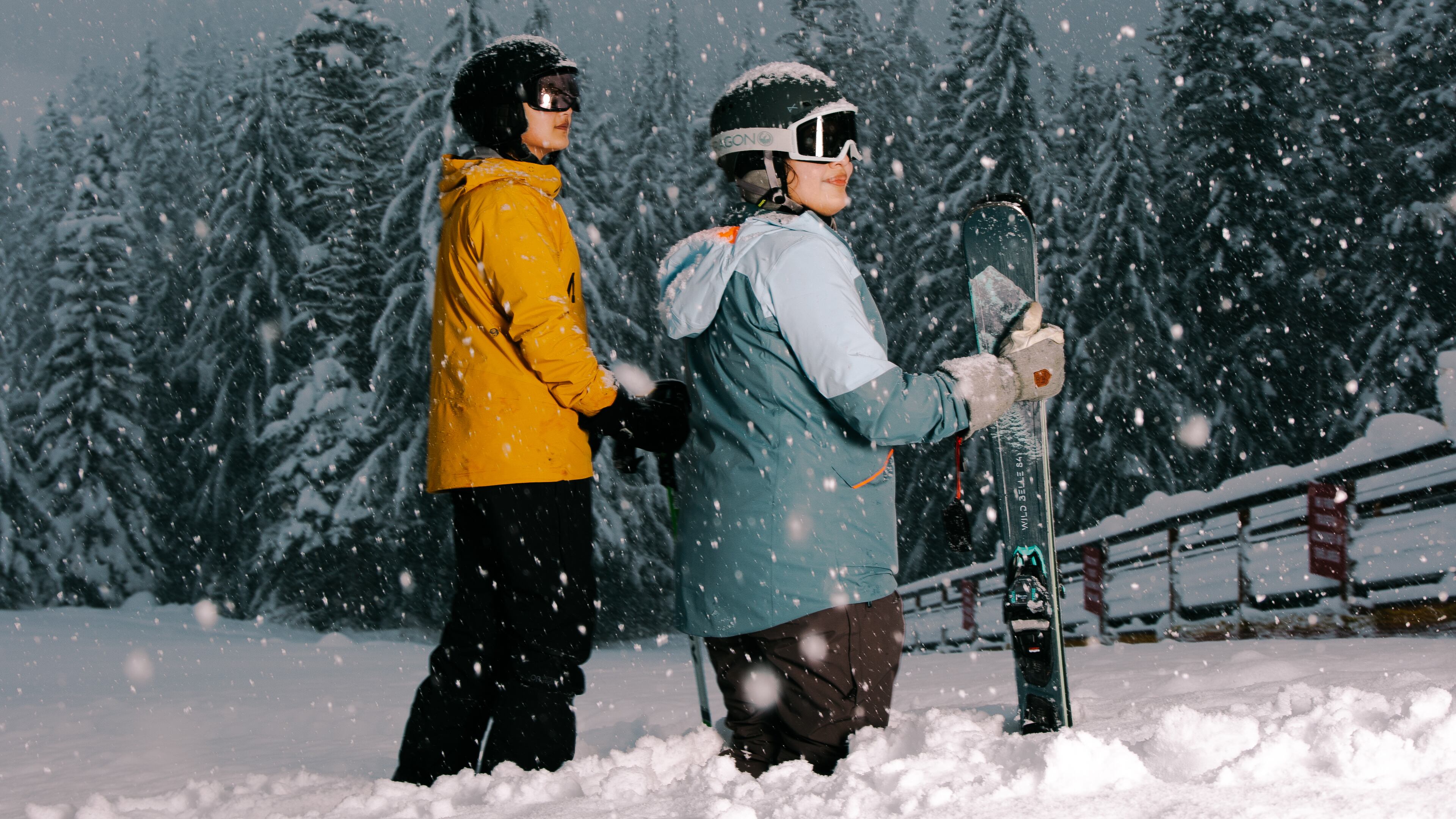For a range of activities held in a wide open winter wonderland, snow sports have a lot of barriers.
From the cost of gear to finding someone to teach you to having a way to traverse a snowy highway to get to a mountain, becoming a seasoned ski bum isn’t as easy as it looks. For Black, Indigenous and people of color, as well as those who are LGBTQ+, it’s even trickier.
But out of the isolation of the pandemic, a mutual aid movement has arisen via social media to increase diversity on the slopes. Born of queer dance party fundraisers and GoFundMe campaigns, two new groups—Open Slopes PDX and POC Nordic—are working to make sure Oregon’s Cascades belong to all.
Both groups started in the winter of 2020, when the drive to get outside was strong because spending time indoors with others could have had deadly consequences. But once they were out there, group organizers said they found the scene rather homogeneous.
Cross-country skiing “is the whitest and least diverse sport I have ever been part of,” says POC Nordic co-founder Nazanin Ghoddousi, who started skiing four years ago. “That was getting really discouraging for me. With 2020, people had time to access the outdoors like never before, but it’s also feeling comfortable and safe being a woman, then being a queer person, then being a person of color.”
Open Slopes PDX co-founder dallas haley says they envisioned their first event as a one-off, which was a fundraiser for eight BIPOC participants and their plus-ones to spend an evening at Mt. Hood Skibowl. Since then, the program has grown in popularity. Last season, there were over 100 applicants for 12 spots.
“It’s all founded on principles of pleasure activism and mutual aid,” haley says. “We had no idea what it would snowball into. Obviously, it’s wildly expensive and difficult to get into this sport. [We] want more queer and Black and brown and Indigenous people on the slopes.”
Denise López, also of Open Slopes, says she grew up in the Portland area as part of a lower-income Indigenous Mexican family, so while she was interested in skiing, no one she knew did it. It wasn’t until she went with her current partner, who grew up skiing, that she caught the bug for downhill.
“Even then, I was feeling super out of place surrounded by white snow and white people,” López says, laughing.
Open Slopes PDX worked with Coalition Snow, a woman-owned snowsports company, and started a GoFundMe campaign to raise money for gear, equipment, lessons from BIPOC instructors, and lift tickets. They’ve organized BIPOC Shred events and queer ski meetups. POC Nordic has also sought financial support through GoFundMe, gotten ski donations from sporting goods company Salomon, and worked with local retailer the Mountain Shop. None of the groups are nonprofits at this point, preferring to take a more grassroots approach, since earning 501(c)(3) status in and of itself can be daunting.
“We would not have been here without Instagram, TikTok and GoFundMe,” says haley, 27. “It’s Gen Z and young millennials passing around the same $20 on Venmo. We are young people catering to young people.”

All the members described their groups as a form of healing—being cheered on, supported and mentored by others who share their life experiences.
“All of the experiences I have outside are amplified by having people to share that joy with,” López, 24, says. “It’s wild to be in a space where people look more like me and share some of the trauma, anxieties and fears that aren’t addressed through [basic] ski school. On a family spiritual side, there’s the connection to land and nature.”
The mutual aid movement isn’t limited to the Cascades; many learned of the snow sport groups through other outdoor organizing efforts like BikePOC, Wild Diversity and queer rock climbing groups. Organizers say people who attend a ski clinic often end up trying other sports. But behind it all is the inherent joy of being on the mountain on a sunny day, escaping Portland’s rain for some vitamin D and the meditative whooshing of skis.
“Being out there, it’s a place you can feel at peace, in relation to the land and everything around you,” says POC Nordic co-founder Catherine Jäger, 35, who grew up in Bend. “When you’re racing, there’s a peace and a calm to it. You have time to notice things around you and be grateful for that. That’s why I’ve always loved it.”
Jäger, an alternative high school teacher who is part of the Citizen Potawatomi Nation, also says she strives to bring more Indigenous people to the mountains.
“I had to take out some of that colonizer mindset and remember who this area is for: We are on stolen Indigenous land. Why aren’t there more people of color in these places? How do we take a sport that’s been so inaccessible and uninviting and make it more accessible?”
POC Nordic’s Ghoddousi, who is Iranian, says she makes cross country a weekday ritual, as she works weekends as a nurse. She drives to the mountains listening to Iranian music, goes skiing, then heads home to make Iranian food.
“It was a way to feel closer to my culture in a time I was feeling super disconnected,” she says of 2020, when she couldn’t travel to see family. “I want people to know everyone should be able to do this for themselves.”

Cross-Country Skiing 101
By Andrea Damewood
Cross-country skiing lacks the panache of downhill, but once you get into it, the benefits are endless. There’s no need for a lift ticket, the gear is cheaper and less specialized, and for my geriatric millennial behind, falling down hurts a hell of a lot less.
Nordic and cross country are used interchangeably to refer to a type of flat-terrain skiing in which participants propel themselves forward because their heels are not fixed in place to their skis like in downhill. Gliding through snow-covered trees at a good clip not only gives you a rush; it’s a fantastic workout.
“It’s a catch-all for about three different disciplines that use different kinds of skis, tracks, terrain,” says Collin Edwards-Hill, a Nordic specialist at Northeast Portland’s Mountain Shop. “It’s a very broad catch-all for a type of skiing that has free heels.”
Edwards-Hill walked us through the three main types of Nordic skiing—classic, touring and backcountry—and shared a few locations for the uninitiated to try it out. Start with a rental (a $30 basic touring package at his shop gets you skis, boots and poles for two nights) to make sure you’re into it, and specialize from there.
Classic
In this style, the skis are skinnier and have no metal edges, meaning they’re less stable and meant to be used in groomed areas that have tracks to follow. This is where you’ll see a lot of racers and fitness buffs.
Nordic touring
This is the most common and versatile of the styles. The skis are a bit wider than classic and have metal edges. “Metal edges are good, they give folks a little more confidence,” Edwards-Hill says. These skis can be used at Sno-Parks that don’t have tracks and still glide just fine.
Backcountry
These skis are wider and have metal edges and are usually a little shorter and more stable. These are for recreationalists who want to get into ungroomed spaces, Edwards-Hill says, like circumnavigating Crater Lake.
Edwards-Hill recommends a lesson first, which you can sign up for at Mt. Hood Meadows or through other local groups. (I have skied on and off since I was a kid. Having someone show you the ropes also works, but a lesson will help you build good habits from the start.)
And as for where to take those skis, there are several excellent locations near Mount Hood: Meadows, Teacup Nordic Snow Park, Trillium Lake (which has epic views of the mountain, and you can ski onto the frozen lake under the right conditions), Bennett Pass Trailhead/Sno-Park and Pocket Creek Sno-Park.
“I feel like skis are the best way to experience the outdoors in wintertime if there’s snow involved,” Edwards-Hill says. “If you’re interested in getting out and covering a fairly large chunk of ground, then skis are a great option for that. Gliding is the biggest thing. If you’re into sliding on snow with two sticks, skis are the way to go for sure.”
